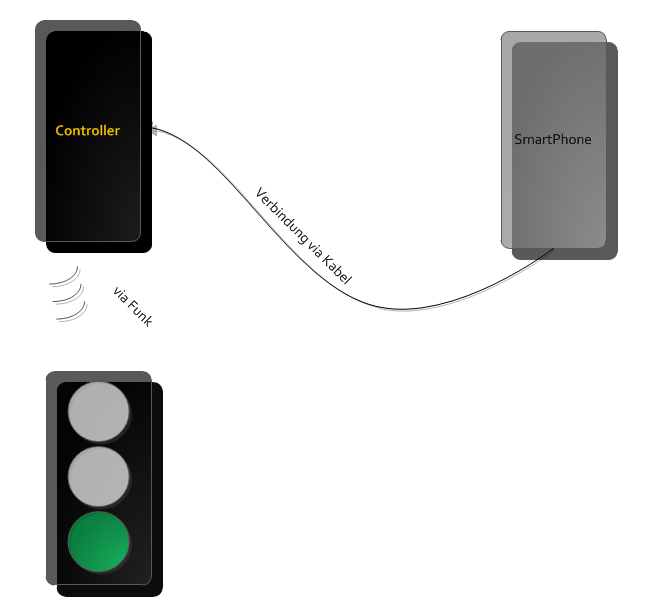Projekt: Sehbehindertenfernsteuerung

Blindenampeln tragen in großem Maße zur Erhöhung der Mobilität Blinder und Sehbehinderter bei. Durch sie wird nicht nur die Sicherheit der Blinden, sondern aller Verkehrsteilnehmer erhöht. GreenWave steht als Sinnbild für grüne Ampeln und dem damit verbundenen, gefahrlosen überqueren der Straße für Sehbehinderte.
Nähert sich der Blinde dem Ampelmast, so orientiert er sich anhand des "Klopfgeräusches". Nach Erreichen des Ampelmastes ertastet der Blinde mit seiner freien Hand das Anforderungskästchen. Den Anforderungstaster für die Freigabesignale findet der Blinde meistens an dessen Unter- bzw. Oberseite. Oft gibt es auch Ampelanlagen, bei denen man direkt den Taster drücken muss, um erst ein Hörsignal zu bekommen. Diese Uneinigkeit, erschwert natürlich dem Sehbehinderten das Auffinden einer Kreuzung und gefährdet dabei nicht nur sich selbst, sondern eben auch seine Mitmenschen im Verkehr. Genau an dieser Stelle kommt unser Projekt zum Einsatz. Mithilfe einer sogenannten Funkfernbedienung, löst ein Blinder in einer bestimmten Entfernung zur Ampel, durch das Drücken eines Taster an der Fernbedienung, das Klopfgeräusch aus und kann sich somit leichter zur Kreuzung hinbewegen.
Da es die Funkfernbedienung nun schon länger gibt jedoch mit manueller Tasterbetätigung, war es unsere Aufgabe, das Ganze so zu dimensionieren, dass dieser Vorgang, mithilfe eines Smartphones, automatisiert wird und lediglich der Standort der jeweiligen Ampel zu speichern ist.
Abstract

Our project should help visually impaired people to find a safety way through the daily traffic. Nowadays it is pretty simple to build such a device quite small. Our project consist out of three main points
-> A smartphone with an android software
-> A microcontroller
-> A remote control for traffic lights which was specially designed for visually impaired people.
With the smartphone it is possible to locate the position of the user at any time. Another thing is that the user has the possibility to add as many locations (for example traffic lights) as he wants to database of the smartphone. These locations can be shown with the help of a Google Maps application. Should the user be nearby a saved location the smartphone sends out an audio signal which will be received from the microcontroller. The microcontroller communicates with the remote control and the remote control sends a special signal to the traffic light and starts the help function for visually impaired people. Instant of pushing the button at the traffic light the user can focus on the knock-noise and find a safety way to the traffic light. A big advantage is that our project uses the newest technologies and so it is state of the art. Another positive aspect is that we use an open-source-software and so any extensions are no problem.
The visually impaired person just has to focus on the ãKnock-noiseÓ of the traffic light. Pushing the button so that the traffic light become green in a few moments is doing by our project.
The costumers benefit is surly the innovation of our project and that our project is a useful tool to find a safety way through the traffic.
Blockschaltbild

Die grundsätzliche Idee ist es einem sehbehinderten Menschen mit Hilfe von modernen Smartphones und einer bereits zum Einsatz kommenden Ampelfernsteuerung, das sichere Bewegen durch den Straßenverkehr zu ermöglichen.
Ziel ist es, dass das Klopf-Geräusch von diversen Fußgängerampeln, welche zuvor manuell in eine Datenbank eingespeichert werden müssen, automatisch ausgelöst wird ohne irgendwelche Tätigkeit des Users.
Das Hauptproblem bestand darin das Smartphone möglichst platz- und energiesparend mit der zu kaufenden Ampelfernsteuerung zu verbinden. Um dies zu schaffen wurde der Audioausgang des Smartphones sowie ein PIC-Programm, welches das ausgegebene Signal interpretiert verwendet. nach oben
